Hyundai Elantra 2003 Owner's Manual
Manufacturer: HYUNDAI, Model Year: 2003, Model line: Elantra, Model: Hyundai Elantra 2003Pages: 172, PDF Size: 2.82 MB
Page 121 of 172
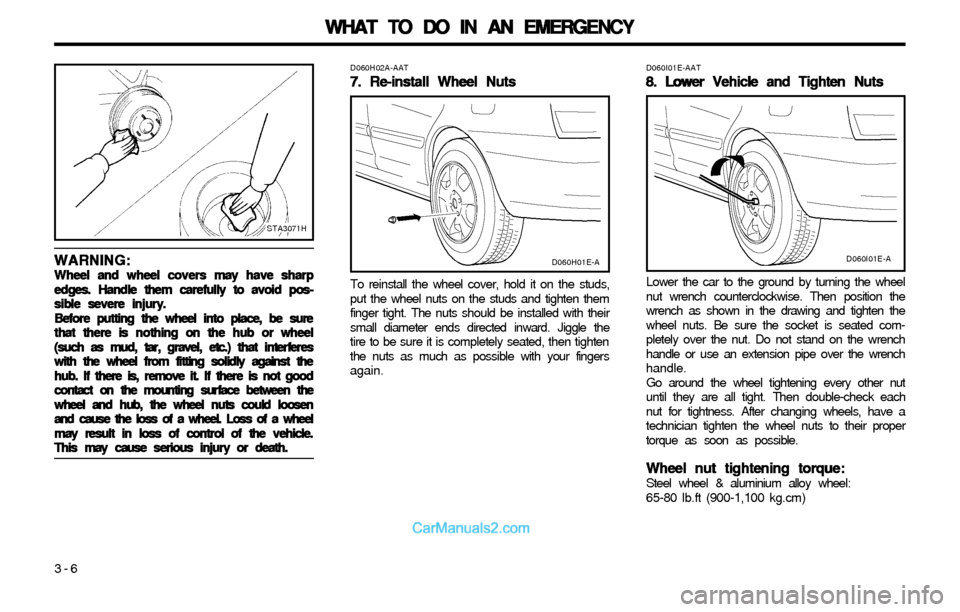
WHAT TO DO IN AN EMERGENCY WHAT TO DO IN AN EMERGENCYWHAT TO DO IN AN EMERGENCY WHAT TO DO IN AN EMERGENCY
WHAT TO DO IN AN EMERGENCY
3-6
STA3071H
WARNING: WARNING:WARNING: WARNING:
WARNING:Wheel and wheel covers may have sharp Wheel and wheel covers may have sharpWheel and wheel covers may have sharp Wheel and wheel covers may have sharp
Wheel and wheel covers may have sharp
edges. Handle them carefully to avoid pos- edges. Handle them carefully to avoid pos-edges. Handle them carefully to avoid pos- edges. Handle them carefully to avoid pos-
edges. Handle them carefully to avoid pos-
sible severe injury. sible severe injury.sible severe injury. sible severe injury.
sible severe injury.
Before putting the wheel into place, be sure Before putting the wheel into place, be sureBefore putting the wheel into place, be sure Before putting the wheel into place, be sure
Before putting the wheel into place, be sure
that there is nothing on the hub or wheel that there is nothing on the hub or wheelthat there is nothing on the hub or wheel that there is nothing on the hub or wheel
that there is nothing on the hub or wheel
(such as mud, tar, gravel, etc.) that interferes (such as mud, tar, gravel, etc.) that interferes(such as mud, tar, gravel, etc.) that interferes (such as mud, tar, gravel, etc.) that interferes
(such as mud, tar, gravel, etc.) that interferes
with the wheel from fitting solidly against the with the wheel from fitting solidly against thewith the wheel from fitting solidly against the with the wheel from fitting solidly against the
with the wheel from fitting solidly against the
hub. If there is, remove it. If there is not good hub. If there is, remove it. If there is not goodhub. If there is, remove it. If there is not good hub. If there is, remove it. If there is not good
hub. If there is, remove it. If there is not good
contact on the mounting surface between the contact on the mounting surface between thecontact on the mounting surface between the contact on the mounting surface between the
contact on the mounting surface between the
wheel and hub, the wheel nuts could loosen wheel and hub, the wheel nuts could loosenwheel and hub, the wheel nuts could loosen wheel and hub, the wheel nuts could loosen
wheel and hub, the wheel nuts could loosen
and cause the loss of a wheel. Loss of a wheel and cause the loss of a wheel. Loss of a wheeland cause the loss of a wheel. Loss of a wheel and cause the loss of a wheel. Loss of a wheel
and cause the loss of a wheel. Loss of a wheel
may result in loss of control of the vehicle. may result in loss of control of the vehicle.may result in loss of control of the vehicle. may result in loss of control of the vehicle.
may result in loss of control of the vehicle.
This may cause serious injury or death. This may cause serious injury or death.This may cause serious injury or death. This may cause serious injury or death.
This may cause serious injury or death.
D060H02A-AAT
7. Re-install Wheel Nuts 7. Re-install Wheel Nuts7. Re-install Wheel Nuts 7. Re-install Wheel Nuts
7. Re-install Wheel Nuts
To reinstall the wheel cover, hold it on the studs,
put the wheel nuts on the studs and tighten them
finger tight. The nuts should be installed with their
small diameter ends directed inward. Jiggle the
tire to be sure it is completely seated, then tighten
the nuts as much as possible with your fingers
again.Lower the car to the ground by turning the wheel
nut wrench counterclockwise. Then position the
wrench as shown in the drawing and tighten the
wheel nuts. Be sure the socket is seated com-
pletely over the nut. Do not stand on the wrench
handle or use an extension pipe over the wrench
handle.
Go around the wheel tightening every other nut
until they are all tight. Then double-check each
nut for tightness. After changing wheels, have a
technician tighten the wheel nuts to their proper
torque as soon as possible.
Wheel nut tightening torque: Wheel nut tightening torque:Wheel nut tightening torque: Wheel nut tightening torque:
Wheel nut tightening torque:Steel wheel & aluminium alloy wheel:
65-80 lb.ft (900-1,100 kg.cm)
D060I01E-AAT
8. Lower Vehicle and Tighten Nuts 8. Lower Vehicle and Tighten Nuts8. Lower Vehicle and Tighten Nuts 8. Lower Vehicle and Tighten Nuts
8. Lower Vehicle and Tighten Nuts
D060H01E-AD060I01E-A
Page 122 of 172
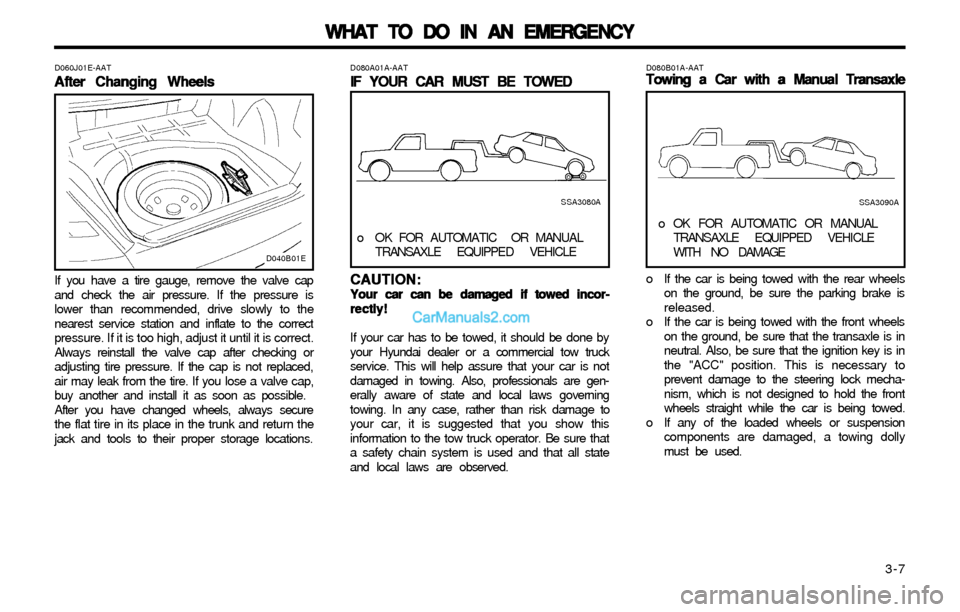
WHAT TO DO IN AN EMERGENCY WHAT TO DO IN AN EMERGENCYWHAT TO DO IN AN EMERGENCY WHAT TO DO IN AN EMERGENCY
WHAT TO DO IN AN EMERGENCY
3-7
D060J01E-AAT
After Changing Wheels After Changing WheelsAfter Changing Wheels After Changing Wheels
After Changing Wheels
If you have a tire gauge, remove the valve cap
and check the air pressure. If the pressure is
lower than recommended, drive slowly to the
nearest service station and inflate to the correct
pressure. If it is too high, adjust it until it is correct.
Always reinstall the valve cap after checking or
adjusting tire pressure. If the cap is not replaced,
air may leak from the tire. If you lose a valve cap,
buy another and install it as soon as possible.
After you have changed wheels, always secure
the flat tire in its place in the trunk and return the
jack and tools to their proper storage locations.
D080A01A-AAT
IF YOUR CAR MUST BE TOWED IF YOUR CAR MUST BE TOWEDIF YOUR CAR MUST BE TOWED IF YOUR CAR MUST BE TOWED
IF YOUR CAR MUST BE TOWED
CAUTION: CAUTION:CAUTION: CAUTION:
CAUTION:
Your car can be damaged if towed incor- Your car can be damaged if towed incor-Your car can be damaged if towed incor- Your car can be damaged if towed incor-
Your car can be damaged if towed incor-
rectly! rectly!rectly! rectly!
rectly!
If your car has to be towed, it should be done by
your Hyundai dealer or a commercial tow truck
service. This will help assure that your car is not
damaged in towing. Also, professionals are gen-
erally aware of state and local laws governing
towing. In any case, rather than risk damage to
your car, it is suggested that you show this
information to the tow truck operator. Be sure that
a safety chain system is used and that all state
and local laws are observed.
D080B01A-AATTowing a Car with a Manual Transaxle Towing a Car with a Manual TransaxleTowing a Car with a Manual Transaxle Towing a Car with a Manual Transaxle
Towing a Car with a Manual Transaxle
o If the car is being towed with the rear wheels
on the ground, be sure the parking brake is
released.
o If the car is being towed with the front wheels
on the ground, be sure that the transaxle is in
neutral. Also, be sure that the ignition key is in
the "ACC" position. This is necessary to
prevent damage to the steering lock mecha-
nism, which is not designed to hold the front
wheels straight while the car is being towed.
o If any of the loaded wheels or suspension
components are damaged, a towing dolly
must be used.
o OK FOR AUTOMATIC OR MANUAL
TRANSAXLE EQUIPPED VEHICLE
SSA3080A
o OK FOR AUTOMATIC OR MANUAL
TRANSAXLE EQUIPPED VEHICLE
WITH NO DAMAGE
SSA3090A
D040B01E
Page 123 of 172

WHAT TO DO IN AN EMERGENCY WHAT TO DO IN AN EMERGENCYWHAT TO DO IN AN EMERGENCY WHAT TO DO IN AN EMERGENCY
WHAT TO DO IN AN EMERGENCY
3-8
D080C02A-AATTowing a Car with an Automatic Towing a Car with an AutomaticTowing a Car with an Automatic Towing a Car with an Automatic
Towing a Car with an Automatic
Transaxle TransaxleTransaxle Transaxle
Transaxle
CAUTION: CAUTION:CAUTION: CAUTION:
CAUTION:
A car with an automatic transaxle should A car with an automatic transaxle shouldA car with an automatic transaxle should A car with an automatic transaxle should
A car with an automatic transaxle should
never be towed from the rear with the front never be towed from the rear with the frontnever be towed from the rear with the front never be towed from the rear with the front
never be towed from the rear with the front
wheels on the ground. This can cause seri- wheels on the ground. This can cause seri-wheels on the ground. This can cause seri- wheels on the ground. This can cause seri-
wheels on the ground. This can cause seri-
ous damage to the transaxle. If the car must ous damage to the transaxle. If the car mustous damage to the transaxle. If the car must ous damage to the transaxle. If the car must
ous damage to the transaxle. If the car must
be towed from the rear, a towing dolly must be towed from the rear, a towing dolly mustbe towed from the rear, a towing dolly must be towed from the rear, a towing dolly must
be towed from the rear, a towing dolly must
be used under the front wheels. be used under the front wheels.be used under the front wheels. be used under the front wheels.
be used under the front wheels.
If the car is being towed with the rear wheels on
the ground, be sure the parking brake is re-
leased.
o NOT OK FOR AUTOMATIC TRANSAXLE
EQUIPPED VEHICLE
o OK FOR MANUAL TRANSAXLE
SSA3100A o OK FOR AUTOMATIC OR MANUAL
TRANSAXLE EQUIPPED VEHICLE
SSA3101AD080D02A-AAT
Emergency Towing Emergency TowingEmergency Towing Emergency Towing
Emergency Towing
For emergency towing when no commercial tow
vehicle is available, attach a tow cable, chain or
strap to one of the tie-down hooks under the front
of your car. Do not attempt to tow your vehicle in
this manner on any unpaved surface. This could
result in serious damage to your car.
Nor should towing be attempted if the wheels,
drive train, axles, steering or brakes are dam-
aged. Before towing, be sure the transaxle is in
neutral and the key is in "ACC" (with the engine
off) or in the "ON" position (with the engine
running). A driver must be in the towed car to
steer it and operate the brakes.
D080D01ENOTE: NOTE:NOTE: NOTE:
NOTE:Before towing, check the level of the tran- Before towing, check the level of the tran-Before towing, check the level of the tran- Before towing, check the level of the tran-
Before towing, check the level of the tran-
saxle fluid. If it is below the "HOT" mark on saxle fluid. If it is below the "HOT" mark onsaxle fluid. If it is below the "HOT" mark on saxle fluid. If it is below the "HOT" mark on
saxle fluid. If it is below the "HOT" mark on
the dipstick, add fluid. If you cannot add fluid, the dipstick, add fluid. If you cannot add fluid,the dipstick, add fluid. If you cannot add fluid, the dipstick, add fluid. If you cannot add fluid,
the dipstick, add fluid. If you cannot add fluid,
a towing dolly must be used as described a towing dolly must be used as describeda towing dolly must be used as described a towing dolly must be used as described
a towing dolly must be used as described
above. above.above. above.
above.
Page 124 of 172

WHAT TO DO IN AN EMERGENCY WHAT TO DO IN AN EMERGENCYWHAT TO DO IN AN EMERGENCY WHAT TO DO IN AN EMERGENCY
WHAT TO DO IN AN EMERGENCY
3-9
D120A01A-AAT
IF YOU LOSE YOUR KEYS IF YOU LOSE YOUR KEYSIF YOU LOSE YOUR KEYS IF YOU LOSE YOUR KEYS
IF YOU LOSE YOUR KEYSIf you lose your keys, many Hyundai dealers can
make you a new key if you have your key
number.
If you lock the keys inside your car and you
cannot obtain a new key, many Hyundai dealers
can use special tools to open the door for you.
CAUTION: CAUTION:CAUTION: CAUTION:
CAUTION:If the car is being towed with all four wheels If the car is being towed with all four wheelsIf the car is being towed with all four wheels If the car is being towed with all four wheels
If the car is being towed with all four wheels
on the ground, it can be towed only from the on the ground, it can be towed only from theon the ground, it can be towed only from the on the ground, it can be towed only from the
on the ground, it can be towed only from the
front. Be sure that the transaxle is in neutral. front. Be sure that the transaxle is in neutral.front. Be sure that the transaxle is in neutral. front. Be sure that the transaxle is in neutral.
front. Be sure that the transaxle is in neutral.
Do not tow at speeds greater than 30 mph (50 Do not tow at speeds greater than 30 mph (50Do not tow at speeds greater than 30 mph (50 Do not tow at speeds greater than 30 mph (50
Do not tow at speeds greater than 30 mph (50
km/h) and for more than 15 miles (25 km). Be km/h) and for more than 15 miles (25 km). Bekm/h) and for more than 15 miles (25 km). Be km/h) and for more than 15 miles (25 km). Be
km/h) and for more than 15 miles (25 km). Be
sure the steering is unlocked by placing the sure the steering is unlocked by placing thesure the steering is unlocked by placing the sure the steering is unlocked by placing the
sure the steering is unlocked by placing the
key in the "ACC" position. A driver must be in key in the "ACC" position. A driver must be inkey in the "ACC" position. A driver must be in key in the "ACC" position. A driver must be in
key in the "ACC" position. A driver must be in
the towed vehicle to operate the steering and the towed vehicle to operate the steering andthe towed vehicle to operate the steering and the towed vehicle to operate the steering and
the towed vehicle to operate the steering and
brakes. brakes.brakes. brakes.
brakes.
Page 125 of 172
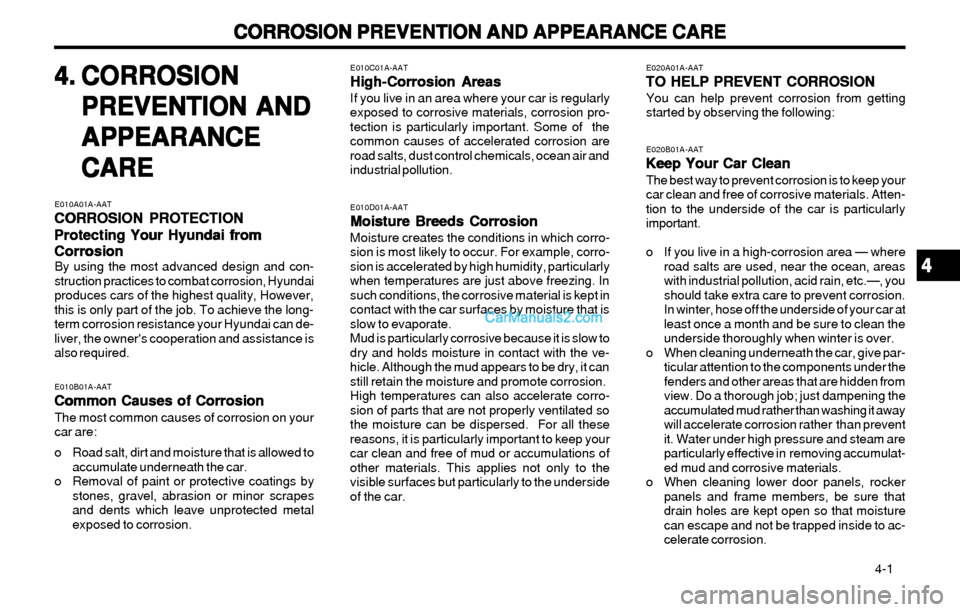
CORROSION PREVENTION AND APPEARANCE CARE CORROSION PREVENTION AND APPEARANCE CARECORROSION PREVENTION AND APPEARANCE CARE CORROSION PREVENTION AND APPEARANCE CARE
CORROSION PREVENTION AND APPEARANCE CARE
4-1
E020B01A-AAT
Keep Your Car Clean Keep Your Car CleanKeep Your Car Clean Keep Your Car Clean
Keep Your Car CleanThe best way to prevent corrosion is to keep your
car clean and free of corrosive materials. Atten-
tion to the underside of the car is particularly
important.
o If you live in a high-corrosion area — where
road salts are used, near the ocean, areas
with industrial pollution, acid rain, etc.—, you
should take extra care to prevent corrosion.
In winter, hose off the underside of your car at
least once a month and be sure to clean the
underside thoroughly when winter is over.
o When cleaning underneath the car, give par-
ticular attention to the components under the
fenders and other areas that are hidden from
view. Do a thorough job; just dampening the
accumulated mud rather than washing it away
will accelerate corrosion rather than prevent
it. Water under high pressure and steam are
particularly effective in removing accumulat-
ed mud and corrosive materials.
o When cleaning lower door panels, rocker
panels and frame members, be sure that
drain holes are kept open so that moisture
can escape and not be trapped inside to ac-
celerate corrosion.
E010A01A-AAT
CORROSION PROTECTION CORROSION PROTECTIONCORROSION PROTECTION CORROSION PROTECTION
CORROSION PROTECTION
Protecting Your Hyundai from Protecting Your Hyundai fromProtecting Your Hyundai from Protecting Your Hyundai from
Protecting Your Hyundai from
Corrosion CorrosionCorrosion Corrosion
Corrosion
By using the most advanced design and con-
struction practices to combat corrosion, Hyundai
produces cars of the highest quality, However,
this is only part of the job. To achieve the long-
term corrosion resistance your Hyundai can de-
liver, the owner's cooperation and assistance is
also required.
4. 4.4. 4.
4.
CORR CORRCORR CORR
CORR
OSION OSIONOSION OSION
OSION
PREVENTION AND PREVENTION ANDPREVENTION AND PREVENTION AND
PREVENTION AND
APPEARANCE APPEARANCEAPPEARANCE APPEARANCE
APPEARANCE
CARE CARECARE CARE
CAREE010C01A-AAT
High-Corrosion Areas High-Corrosion AreasHigh-Corrosion Areas High-Corrosion Areas
High-Corrosion AreasIf you live in an area where your car is regularly
exposed to corrosive materials, corrosion pro-
tection is particularly important. Some of the
common causes of accelerated corrosion are
road salts, dust control chemicals, ocean air and
industrial pollution.
E010B01A-AAT
Common Causes of Corrosion Common Causes of CorrosionCommon Causes of Corrosion Common Causes of Corrosion
Common Causes of CorrosionThe most common causes of corrosion on your
car are:
o Road salt, dirt and moisture that is allowed to
accumulate underneath the car.
o Removal of paint or protective coatings by
stones, gravel, abrasion or minor scrapes
and dents which leave unprotected metal
exposed to corrosion.
E010D01A-AAT
Moisture Breeds Corrosion Moisture Breeds CorrosionMoisture Breeds Corrosion Moisture Breeds Corrosion
Moisture Breeds CorrosionMoisture creates the conditions in which corro-
sion is most likely to occur. For example, corro-
sion is accelerated by high humidity, particularly
when temperatures are just above freezing. In
such conditions, the corrosive material is kept in
contact with the car surfaces by moisture that is
slow to evaporate.
Mud is particularly corrosive because it is slow to
dry and holds moisture in contact with the ve-
hicle. Although the mud appears to be dry, it can
still retain the moisture and promote corrosion.
High temperatures can also accelerate corro-
sion of parts that are not properly ventilated so
the moisture can be dispersed. For all these
reasons, it is particularly important to keep your
car clean and free of mud or accumulations of
other materials. This applies not only to the
visible surfaces but particularly to the underside
of the car.
E020A01A-AAT
TO HELP PREVENT CORROSION TO HELP PREVENT CORROSIONTO HELP PREVENT CORROSION TO HELP PREVENT CORROSION
TO HELP PREVENT CORROSIONYou can help prevent corrosion from getting
started by observing the following:
4 44 4
4
Page 126 of 172
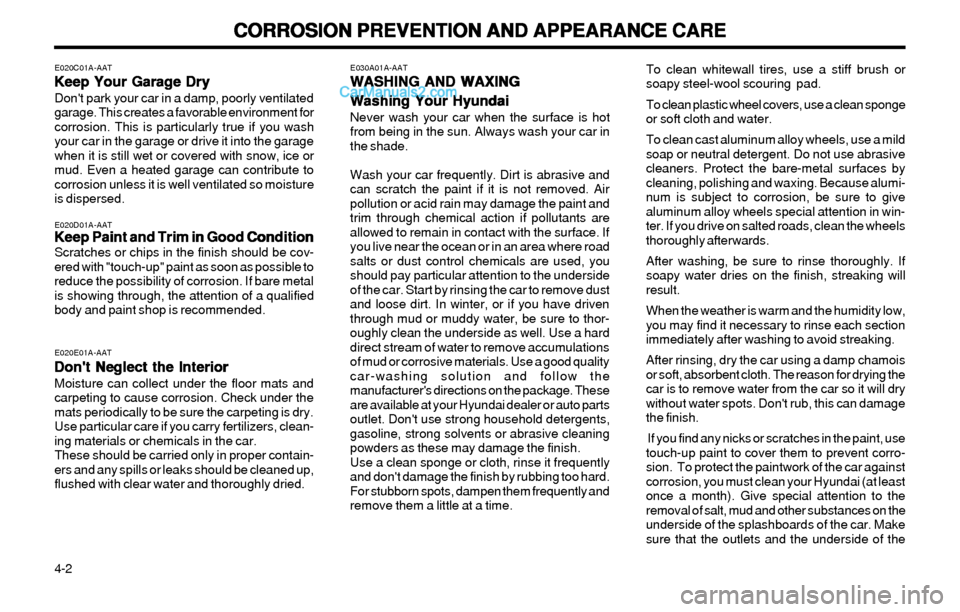
CORROSION PREVENTION AND APPEARANCE CARE CORROSION PREVENTION AND APPEARANCE CARECORROSION PREVENTION AND APPEARANCE CARE CORROSION PREVENTION AND APPEARANCE CARE
CORROSION PREVENTION AND APPEARANCE CARE
4-2
E020C01A-AAT
Keep Your Garage Dry Keep Your Garage DryKeep Your Garage Dry Keep Your Garage Dry
Keep Your Garage DryDon't park your car in a damp, poorly ventilated
garage. This creates a favorable environment for
corrosion. This is particularly true if you wash
your car in the garage or drive it into the garage
when it is still wet or covered with snow, ice or
mud. Even a heated garage can contribute to
corrosion unless it is well ventilated so moisture
is dispersed.
E020D01A-AATKeep Paint and Trim in Good Condition Keep Paint and Trim in Good ConditionKeep Paint and Trim in Good Condition Keep Paint and Trim in Good Condition
Keep Paint and Trim in Good ConditionScratches or chips in the finish should be cov-
ered with "touch-up" paint as soon as possible to
reduce the possibility of corrosion. If bare metal
is showing through, the attention of a qualified
body and paint shop is recommended.
E020E01A-AAT
Don't Neglect the Interior Don't Neglect the InteriorDon't Neglect the Interior Don't Neglect the Interior
Don't Neglect the InteriorMoisture can collect under the floor mats and
carpeting to cause corrosion. Check under the
mats periodically to be sure the carpeting is dry.
Use particular care if you carry fertilizers, clean-
ing materials or chemicals in the car.
These should be carried only in proper contain-
ers and any spills or leaks should be cleaned up,
flushed with clear water and thoroughly dried.
E030A01A-AAT
WASHING AND WAXING WASHING AND WAXINGWASHING AND WAXING WASHING AND WAXING
WASHING AND WAXING
Washing Your Hyundai Washing Your HyundaiWashing Your Hyundai Washing Your Hyundai
Washing Your Hyundai
Never wash your car when the surface is hot
from being in the sun. Always wash your car in
the shade.
Wash your car frequently. Dirt is abrasive and
can scratch the paint if it is not removed. Air
pollution or acid rain may damage the paint and
trim through chemical action if pollutants are
allowed to remain in contact with the surface. If
you live near the ocean or in an area where road
salts or dust control chemicals are used, you
should pay particular attention to the underside
of the car. Start by rinsing the car to remove dust
and loose dirt. In winter, or if you have driven
through mud or muddy water, be sure to thor-
oughly clean the underside as well. Use a hard
direct stream of water to remove accumulations
of mud or corrosive materials. Use a good quality
car-washing solution and follow the
manufacturer's directions on the package. These
are available at your Hyundai dealer or auto parts
outlet. Don't use strong household detergents,
gasoline, strong solvents or abrasive cleaning
powders as these may damage the finish.
Use a clean sponge or cloth, rinse it frequently
and don't damage the finish by rubbing too hard.
For stubborn spots, dampen them frequently and
remove them a little at a time.To clean whitewall tires, use a stiff brush or
soapy steel-wool scouring pad.
To clean plastic wheel covers, use a clean sponge
or soft cloth and water.
To clean cast aluminum alloy wheels, use a mild
soap or neutral detergent. Do not use abrasive
cleaners. Protect the bare-metal surfaces by
cleaning, polishing and waxing. Because alumi-
num is subject to corrosion, be sure to give
aluminum alloy wheels special attention in win-
ter. If you drive on salted roads, clean the wheels
thoroughly afterwards.
After washing, be sure to rinse thoroughly. If
soapy water dries on the finish, streaking will
result.
When the weather is warm and the humidity low,
you may find it necessary to rinse each section
immediately after washing to avoid streaking.
After rinsing, dry the car using a damp chamois
or soft, absorbent cloth. The reason for drying the
car is to remove water from the car so it will dry
without water spots. Don't rub, this can damage
the finish.
If you find any nicks or scratches in the paint, use
touch-up paint to cover them to prevent corro-
sion. To protect the paintwork of the car against
corrosion, you must clean your Hyundai (at least
once a month). Give special attention to the
removal of salt, mud and other substances on the
underside of the splashboards of the car. Make
sure that the outlets and the underside of the
Page 127 of 172
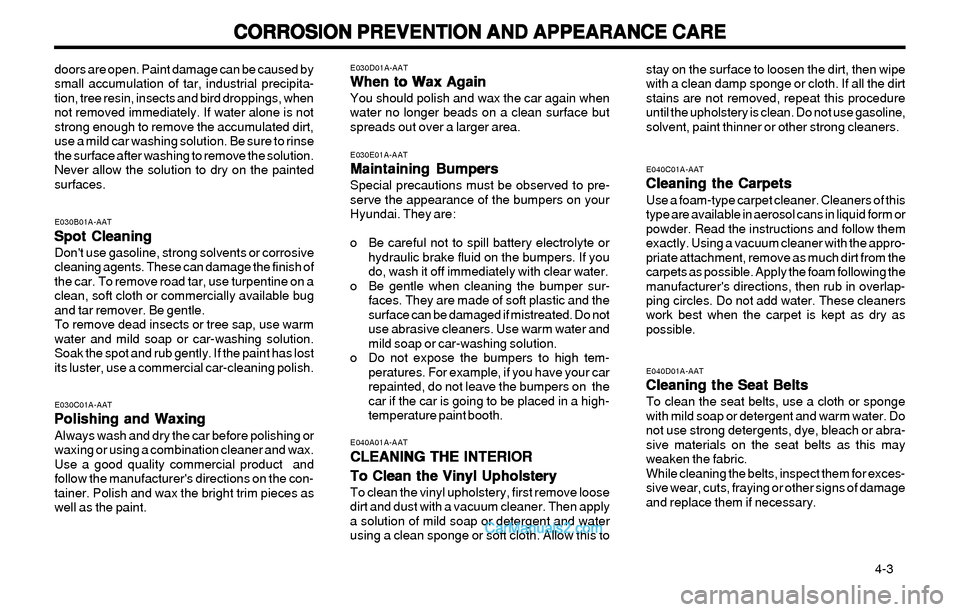
CORROSION PREVENTION AND APPEARANCE CARE CORROSION PREVENTION AND APPEARANCE CARECORROSION PREVENTION AND APPEARANCE CARE CORROSION PREVENTION AND APPEARANCE CARE
CORROSION PREVENTION AND APPEARANCE CARE
4-3 doors are open. Paint damage can be caused by
small accumulation of tar, industrial precipita-
tion, tree resin, insects and bird droppings, when
not removed immediately. If water alone is not
strong enough to remove the accumulated dirt,
use a mild car washing solution. Be sure to rinse
the surface after washing to remove the solution.
Never allow the solution to dry on the painted
surfaces.
E030D01A-AAT
When to Wax Again When to Wax AgainWhen to Wax Again When to Wax Again
When to Wax AgainYou should polish and wax the car again when
water no longer beads on a clean surface but
spreads out over a larger area.
E030E01A-AAT
Maintaining Bumpers Maintaining BumpersMaintaining Bumpers Maintaining Bumpers
Maintaining BumpersSpecial precautions must be observed to pre-
serve the appearance of the bumpers on your
Hyundai. They are:
o Be careful not to spill battery electrolyte or
hydraulic brake fluid on the bumpers. If you
do, wash it off immediately with clear water.
o Be gentle when cleaning the bumper sur-
faces. They are made of soft plastic and the
surface can be damaged if mistreated. Do not
use abrasive cleaners. Use warm water and
mild soap or car-washing solution.
o Do not expose the bumpers to high tem-
peratures. For example, if you have your car
repainted, do not leave the bumpers on the
car if the car is going to be placed in a high-
temperature paint booth.
E040A01A-AAT
CLEANING THE INTERIOR CLEANING THE INTERIORCLEANING THE INTERIOR CLEANING THE INTERIOR
CLEANING THE INTERIOR
To Clean the Vinyl Upholstery To Clean the Vinyl UpholsteryTo Clean the Vinyl Upholstery To Clean the Vinyl Upholstery
To Clean the Vinyl Upholstery
To clean the vinyl upholstery, first remove loose
dirt and dust with a vacuum cleaner. Then apply
a solution of mild soap or detergent and water
using a clean sponge or soft cloth. Allow this tostay on the surface to loosen the dirt, then wipe
with a clean damp sponge or cloth. If all the dirt
stains are not removed, repeat this procedure
until the upholstery is clean. Do not use gasoline,
solvent, paint thinner or other strong cleaners.
E030B01A-AAT
Spot Cleaning Spot CleaningSpot Cleaning Spot Cleaning
Spot CleaningDon't use gasoline, strong solvents or corrosive
cleaning agents. These can damage the finish of
the car. To remove road tar, use turpentine on a
clean, soft cloth or commercially available bug
and tar remover. Be gentle.
To remove dead insects or tree sap, use warm
water and mild soap or car-washing solution.
Soak the spot and rub gently. If the paint has lost
its luster, use a commercial car-cleaning polish.
E030C01A-AAT
Polishing and Waxing Polishing and WaxingPolishing and Waxing Polishing and Waxing
Polishing and WaxingAlways wash and dry the car before polishing or
waxing or using a combination cleaner and wax.
Use a good quality commercial product and
follow the manufacturer's directions on the con-
tainer. Polish and wax the bright trim pieces as
well as the paint.
E040D01A-AAT
Cleaning the Seat Belts Cleaning the Seat BeltsCleaning the Seat Belts Cleaning the Seat Belts
Cleaning the Seat BeltsTo clean the seat belts, use a cloth or sponge
with mild soap or detergent and warm water. Do
not use strong detergents, dye, bleach or abra-
sive materials on the seat belts as this may
weaken the fabric.
While cleaning the belts, inspect them for exces-
sive wear, cuts, fraying or other signs of damage
and replace them if necessary.
E040C01A-AAT
Cleaning the Carpets Cleaning the CarpetsCleaning the Carpets Cleaning the Carpets
Cleaning the CarpetsUse a foam-type carpet cleaner. Cleaners of this
type are available in aerosol cans in liquid form or
powder. Read the instructions and follow them
exactly. Using a vacuum cleaner with the appro-
priate attachment, remove as much dirt from the
carpets as possible. Apply the foam following the
manufacturer's directions, then rub in overlap-
ping circles. Do not add water. These cleaners
work best when the carpet is kept as dry as
possible.
Page 128 of 172
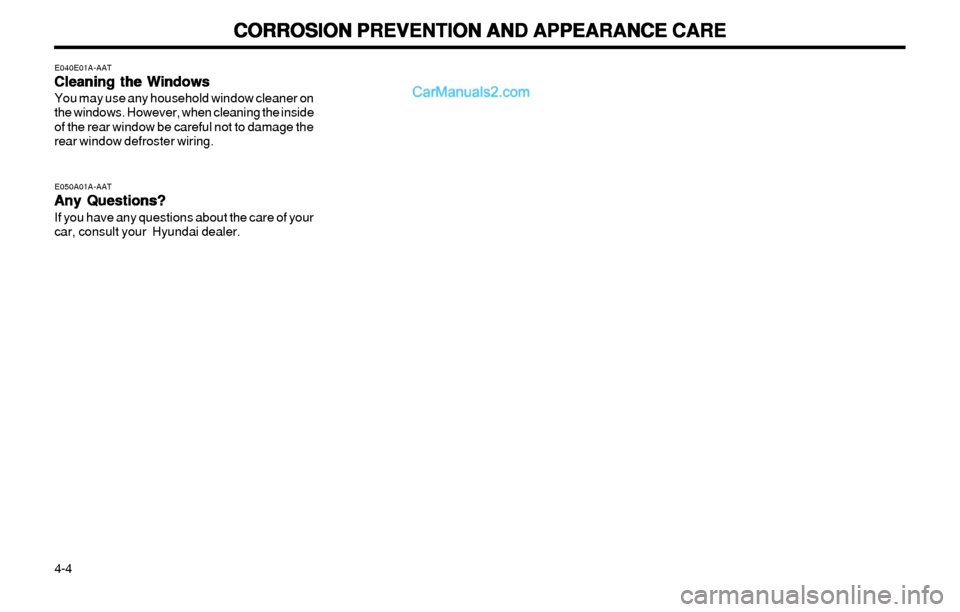
CORROSION PREVENTION AND APPEARANCE CARE CORROSION PREVENTION AND APPEARANCE CARECORROSION PREVENTION AND APPEARANCE CARE CORROSION PREVENTION AND APPEARANCE CARE
CORROSION PREVENTION AND APPEARANCE CARE
4-4
E040E01A-AAT
Cleaning the Windows Cleaning the WindowsCleaning the Windows Cleaning the Windows
Cleaning the WindowsYou may use any household window cleaner on
the windows. However, when cleaning the inside
of the rear window be careful not to damage the
rear window defroster wiring.
E050A01A-AAT
Any Questions? Any Questions?Any Questions? Any Questions?
Any Questions?If you have any questions about the care of your
car, consult your Hyundai dealer.
Page 129 of 172

VEHICLE MAINTENANCE REQUIREMENTS VEHICLE MAINTENANCE REQUIREMENTSVEHICLE MAINTENANCE REQUIREMENTS VEHICLE MAINTENANCE REQUIREMENTS
VEHICLE MAINTENANCE REQUIREMENTS
5-1
F010C01A-AAT
Specified Scheduled Procedures Specified Scheduled ProceduresSpecified Scheduled Procedures Specified Scheduled Procedures
Specified Scheduled ProceduresThese are the procedures such as inspec-
tions, adjustments and replacements that are
listed in the maintenance charts starting on
page 5-3. These procedures must be per-
formed at the intervals shown in the mainte-
nance schedule to assure that your warranty
remains in effect. Although it is strongly rec-
ommended that they be performed by the
trained technicians at your Hyundai dealer,
these procedures may be performed at any
qualified service facility.
It is suggested that genuine Hyundai service
parts be used for any required repairs or
replacements. Other parts of equivalent qual-
ity such as engine oil, engine coolant, manual
or auto transaxle oil, brake fluid and so on
which are not supplied by Hyundai Motor
Company or its distributor may be used with-
out affecting your warranty coverage but you
should always be sure these are equivalent to
the quality of the original Hyundai parts. Your
Owner's Handbook provides further informa-
tion about your warranty coverage.
5. 5.5. 5.
5.
VEHICLE VEHICLEVEHICLE VEHICLE
VEHICLE
MAINTENANCE MAINTENANCEMAINTENANCE MAINTENANCE
MAINTENANCE
REQUIREMENTS REQUIREMENTSREQUIREMENTS REQUIREMENTS
REQUIREMENTSF010E01A-AAT
Do-It-Yourself Maintenance Do-It-Yourself MaintenanceDo-It-Yourself Maintenance Do-It-Yourself Maintenance
Do-It-Yourself MaintenanceIf you are mechanically inclined, own a few tools
that are required and want to take the time to do
so, you can inspect and service a number of
items. For more information about doing it
yourself, see Section 6.
F010D01A-AAT
General Checks General ChecksGeneral Checks General Checks
General ChecksThese are the regular checks you should
perform when you drive your Hyundai or you
fill the fuel tank. A list of these items will be
found on page 6-3.
F010A01A-AAT
MAINTENANCE INTERVALS MAINTENANCE INTERVALSMAINTENANCE INTERVALS MAINTENANCE INTERVALS
MAINTENANCE INTERVALS
Service Requirements Service RequirementsService Requirements Service Requirements
Service Requirements
To ensure that you receive the greatest num-
ber of miles of satisfying operation from your
Hyundai, certain maintenance procedures
must be performed. Although careful design
and engineering have reduced these to a
minimum, those that are required are of the
utmost importance.
It is your responsibility to have these mainte-
nance procedures performed to comply with
the terms of the warranties covering your new
Hyundai. The Owner's Handbook supplied
with your new vehicle provides further infor-
mation about these warranties.
F010B01A-AAT
Maintenance Requirements Maintenance RequirementsMaintenance Requirements Maintenance Requirements
Maintenance RequirementsThe maintenance required for your Hyundai
can be divided into three main areas:
o Specified scheduled procedures
o General checks
o Do-it-yourself maintenance
F010F01A-AAT
A Few Tips A Few TipsA Few Tips A Few Tips
A Few Tipso Whenever you have your Hyundai ser-
viced, keep copies of the service records
in your glovebox. This will help assure you
can document the required procedures
being performed to keep your warranties
in effect. This is especially important when
service is not performed by an authorized
Hyundai dealer.
o If you choose to do your own maintenance
and repairs, you may find it helpful to have
an official Hyundai Shop Manual. A copy of
this publication may be purchased at your
Hyundai dealer's parts department.
5 55 5
5
Page 130 of 172
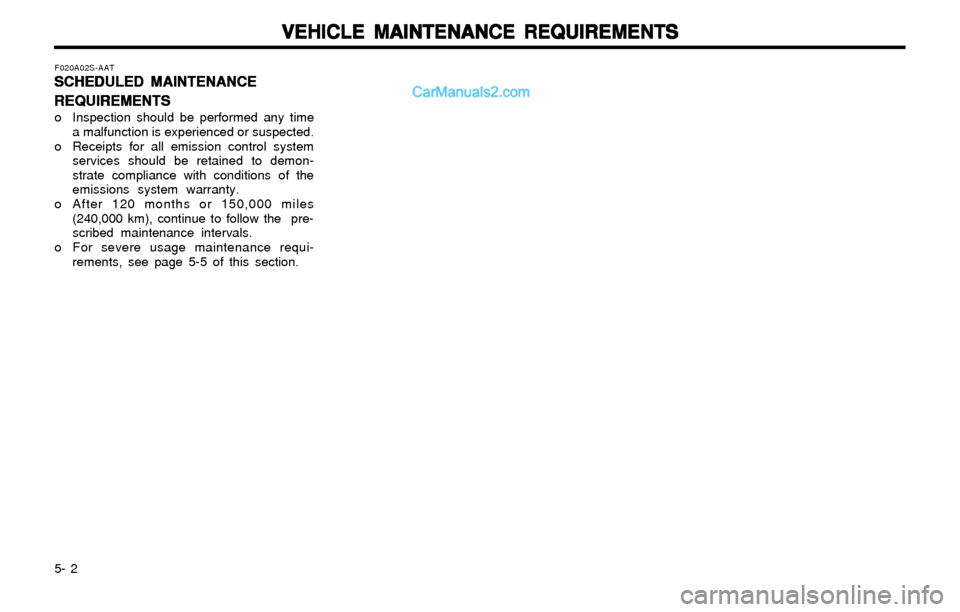
VEHICLE MAINTENANCE REQUIREMENTS VEHICLE MAINTENANCE REQUIREMENTSVEHICLE MAINTENANCE REQUIREMENTS VEHICLE MAINTENANCE REQUIREMENTS
VEHICLE MAINTENANCE REQUIREMENTS
5- 2
F020A02S-AAT
SCHEDULED MAINTENANCE SCHEDULED MAINTENANCESCHEDULED MAINTENANCE SCHEDULED MAINTENANCE
SCHEDULED MAINTENANCE
REQUIREMENTS REQUIREMENTSREQUIREMENTS REQUIREMENTS
REQUIREMENTS
o Inspection should be performed any time
a malfunction is experienced or suspected.
o Receipts for all emission control system
services should be retained to demon-
strate compliance with conditions of the
emissions system warranty.
o After 120 months or 150,000 miles
(240,000 km), continue to follow the pre-
scribed maintenance intervals.
o For severe usage maintenance requi-
rements, see page 5-5 of this section.